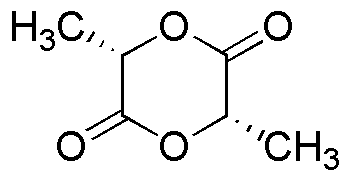L-(-)-Lactide is widely utilized in research focused on:
- Biodegradable Plastics: L-(-)-Lactide is a key component in the production of polylactic acid (PLA), a biodegradable plastic used in packaging, disposable utensils, and agricultural films. Its eco-friendly nature appeals to industries aiming to reduce plastic waste.
- Medical Devices: This compound is used to create biocompatible and biodegradable sutures and implants. Its ability to break down safely in the body makes it ideal for temporary medical devices, reducing the need for surgical removal.
- Drug Delivery Systems: L-(-)-Lactide is incorporated into drug delivery formulations, allowing for controlled release of medications. This application is particularly beneficial in cancer therapies, where sustained drug release can enhance treatment efficacy.
- Textiles: The textile industry utilizes L-(-)-Lactide in the production of biodegradable fibers. These fibers offer an environmentally friendly alternative to conventional synthetic fibers, appealing to eco-conscious consumers.
- Food Packaging: Its use in food packaging materials helps extend shelf life while being environmentally friendly. L-(-)-Lactide-based films are effective barriers against moisture and gases, ensuring food quality without harming the environment.
General Information
Properties
Safety and Regulations
Applications
L-(-)-Lactide is widely utilized in research focused on:
- Biodegradable Plastics: L-(-)-Lactide is a key component in the production of polylactic acid (PLA), a biodegradable plastic used in packaging, disposable utensils, and agricultural films. Its eco-friendly nature appeals to industries aiming to reduce plastic waste.
- Medical Devices: This compound is used to create biocompatible and biodegradable sutures and implants. Its ability to break down safely in the body makes it ideal for temporary medical devices, reducing the need for surgical removal.
- Drug Delivery Systems: L-(-)-Lactide is incorporated into drug delivery formulations, allowing for controlled release of medications. This application is particularly beneficial in cancer therapies, where sustained drug release can enhance treatment efficacy.
- Textiles: The textile industry utilizes L-(-)-Lactide in the production of biodegradable fibers. These fibers offer an environmentally friendly alternative to conventional synthetic fibers, appealing to eco-conscious consumers.
- Food Packaging: Its use in food packaging materials helps extend shelf life while being environmentally friendly. L-(-)-Lactide-based films are effective barriers against moisture and gases, ensuring food quality without harming the environment.
Documents
Safety Data Sheets (SDS)
The SDS provides comprehensive safety information on handling, storage, and disposal of the product.
Product Specification (PS)
The PS provides a comprehensive breakdown of the product’s properties, including chemical composition, physical state, purity, and storage requirements. It also details acceptable quality ranges and the product's intended applications.
Certificates of Analysis (COA)
Search for Certificates of Analysis (COA) by entering the products Lot Number. Lot and Batch Numbers can be found on a product’s label following the words ‘Lot’ or ‘Batch’.
*Catalog Number
*Lot Number
Certificates Of Origin (COO)
This COO confirms the country where the product was manufactured, and also details the materials and components used in it and whether it is derived from natural, synthetic, or other specific sources. This certificate may be required for customs, trade, and regulatory compliance.
*Catalog Number
*Lot Number
Safety Data Sheets (SDS)
The SDS provides comprehensive safety information on handling, storage, and disposal of the product.
DownloadProduct Specification (PS)
The PS provides a comprehensive breakdown of the product’s properties, including chemical composition, physical state, purity, and storage requirements. It also details acceptable quality ranges and the product's intended applications.
DownloadCertificates of Analysis (COA)
Search for Certificates of Analysis (COA) by entering the products Lot Number. Lot and Batch Numbers can be found on a product’s label following the words ‘Lot’ or ‘Batch’.
*Catalog Number
*Lot Number
Certificates Of Origin (COO)
This COO confirms the country where the product was manufactured, and also details the materials and components used in it and whether it is derived from natural, synthetic, or other specific sources. This certificate may be required for customs, trade, and regulatory compliance.


